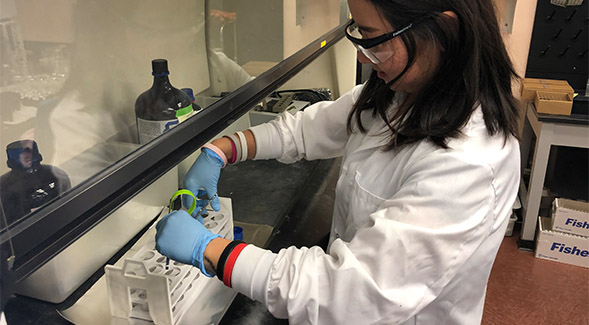SDSU Researchers Find New Way to Measure Nicotine Exposure in Children
A team of researchers from SDSU have found silicone wristbands to be an effective way to measure childrens exposure to second-hand smoke.

Jenny Quintana and her research team at San Diego State University’s School of Public Health, have developed wristbands children can wear as an effective tool to measure nicotine exposure. Similar wristbands have been used to measure exposure to other toxic chemicals like pesticides and flame retardant, but never before for second-hand smoke exposure in children.
“It is important to measure exposure in all groups, but children are often overlooked because it’s difficult to test them,” said Quintana, an SDSU professor. “Children are more challenging than adults, but if you don’t measure exposure well, you will not be able to tell if interventions or policy changes or other things actually worked and had an effect.”
The wristbands, which are made of silicone and resemble the kind bearing motivational messages, were placed on three groups of kids divided by exposure type. The groups included children exposed to nonsmokers and non-e-cigarette users; children exposed only to smokers; and finally, children exposed only to e-cigarette users. Researchers directed the children to wear one wristband for two days and then two wristbands for seven days.
After the seven days of usage, urine samples were collected from the children, a more traditional method of documenting exposure. The prevalence of metabolized nicotine in urine, cotinine, was compared to the nicotine measurements recorded by the wristbands. The tests revealed the two forms of measurement produced comparable results, meaning Quintana’s team had developed a simpler way of testing toxicant exposure in children.
“We were extremely surprised with how well the data correlated,” said Quintana. “It is also amazing how well this worked with such simple instructions. We just told the kids to wear the wristbands.”
Quintana and her team determined that these silicone wristbands may become a useful tool for epidemiology and intervention studies of tobacco product exposure in children and adults in the future. Their findings are detailed in an article in the Journal of Exposure Science & Environmental Epidemiology.
“This is all exciting because it can potentially measure exposure in adults and exposure to more than just nicotine,” said Quintana. “We can now think about using these wristbands to measure other compounds such as car or truck exhaust and other air pollutants in impacted communities.”
Quintana’s work is representative of long-term efforts by SDSU researchers to measure second- and third-hand smoke in people of all ages. Quintana and a team at SDSU have studied residual tobacco effects on material items and exposure to third-hand smoke. They plan to continue this third-hand smoke exposure research using the wristbands.
Eunha Hoh, a collaborator with Quintana and also a professor at SDSU, recently co-authored an article in Environmental Science & Technology with assistant professor Carlos Manzano. They used the wristbands to measure and track patterns of personal exposure to urban air pollution among people living and working in Chile.
“This used the wristbands and a non-targeted analysis,” said Hoh. “We weren’t looking for just nicotine or one particular chemical; we looked at a wide range of chemicals. This was really a proof of concept study and a great finding for the future of these wristbands and second- and third-hand smoke exposure studies.”


